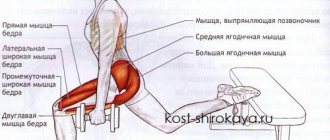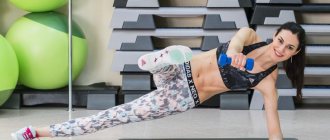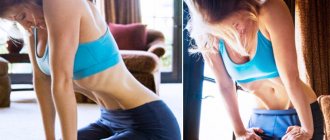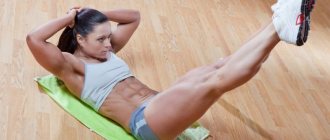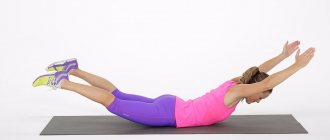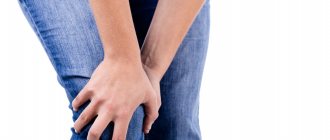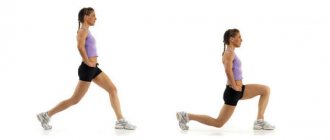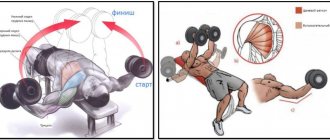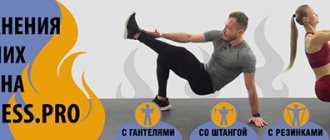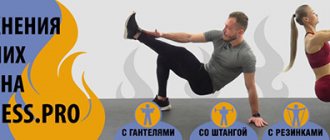Hi all! Today we will talk about such effective exercises as lunges with dumbbells in hands, consider the technique of doing them, which muscles work, and I will give some useful tips .
It's no secret that beautiful legs and pumped buttocks are an integral part of a beautiful figure for both girls and guys. Therefore, most of the training time is spent on this part of the body. To work on these zones, use various exercises with weights of your own body and various objects.
What muscles are involved?
If we analyze this exercise to understand which muscles are being loaded, we will get the following information:
- The quadriceps femoris muscle (quadriceps, which is located on the anterolateral surface) takes the most active part in performing lunges. Thanks to it, the knee joint extends when rising to its original position.
- The muscles of the buttocks (large, medium and small) bear a large load along with the quadriceps, since when lifting upward it extends the thigh.
- The abdominal muscles, biceps femoris, calf muscles and back muscles perform an additional function - supporting the core. The arm muscles are also stressed because they hold the dumbbells.
This exercise not only develops strength abilities, but also develops coordination, since it is not always possible to hold the body in this position the first time.
The width of the step affects what will be tensed more - the muscles of the thigh or buttocks:
- if the step is made wider, and the angle at the knee of the supporting leg becomes more than 90 degrees, then most of the load will go to the gluteal muscle, which is more suitable for girls, however, the greater the lunge forward, the more inconvenient it is to return to the starting position;
- with a narrow step, the muscles of the front surface of the thigh are involved in the work, since the angle of flexion of the supporting leg is 90 degrees.
Working muscles
Dumbbell lunges and barbell lunges are great core leg exercises that work the quadriceps, hamstrings, glutes, back, and give you a clear feel for which muscles are being worked.
The exercise helps to pump up the buttocks and thighs very well - to give them relief and work out all the other muscles. In addition, the exercise is perfect for many sports where coordination, balance and explosive power are needed, for example, athletics, martial arts, cycling.
Canadian Doug Proden set 9 world and 13 national fitness records. He did 5,557 push-ups in 3 hours, 2 minutes, 30 seconds and did 667 one-arm push-ups in an hour. His achievements are listed in the Guinness Book of Records and the Book of Alternative Records.
Basic
If we analyze which muscles work during lunges with dumbbells, we get the following picture:
- The quadriceps is one of the two main working groups. This muscle extends the limb at the knee joint when we rise from the lowest point.
- Lunges with dumbbells are great for the buttocks - along with the quadriceps, they experience significant stress when extending the hip when lifting up.
Additional
In addition to the quadriceps and gluteus maximus, the following muscles take part in the work: the abdominal muscles, gluteus medius, hamstrings, back muscles, calf muscles, etc. The main function of the listed muscles in this exercise is to stabilize the position of the body and legs.
It’s not for nothing that the movement is called coordination complex - it’s true that maintaining balance is not always possible the first time. You can also mention the arm muscles with which you hold dumbbells - they work statically .
By varying the width of the step when performing the exercise, you can shift the load towards the buttocks or towards the quadriceps:
- The step is wider, the supporting limb has an angle at the knee of more than 90 degrees - the gluteal muscle stretches better and works more. This is the best option for most girls. However, the wider your feet are, the less comfortable it is to step and walk back.
- The step is narrower, the supporting leg is bent at a right angle - the front surface of the thigh is more involved.
Benefits of Lunges with Dumbbells
Undoubtedly, this exercise has many advantages:
- Burning a large number of calories due to the work of the muscles of the legs and back;
- Replaces squats with a barbell for back or lower back pain;
- Allows you to improve coordination of movements;
- You can practice both at home, if you have equipment, and in the gym;
- Does not require much space to work;
- Lunges with dumbbells will help get rid of back pain;
- Helps to pump up the muscles of the thighs, buttocks and overall physical endurance.
Precautions when performing lunges
Lunges are contraindicated for varicose veins in the legs and pain in the knees. With osteochondrosis, lower back pain, hernia, protrusion, there is also a certain health risk, that is, the exercise should be performed with extreme caution.
There are interesting variations of lunges - curtsy, sideways, Bulgarian, with a barbell on the shoulders, reverse and in the Smith machine. To avoid injury, stretch before lunging.
Source: https://bodystatus.ru
Difficulties and disadvantages of implementation
- The main difficulty is to “feel” the coordination of movement while performing the exercise without violating the technique. For beginners, it is better to start lunges without dumbbells. Then, as you feel the correctness of the movements, move on to working with weights, constantly increasing the weight.
- To hold heavy equipment in your hands, you will have to use straps or switch to a barbell.
- If you are a trained athlete with a lot of experience, then I recommend doing squats with a barbell as a base, and using lunges as a way to “build up” the muscles.
Lunge technique
The exercise itself - lunges - is basic for working on the muscles of the legs (especially the quadriceps) and buttocks.
Here is the technique for performing lunges:
- choose 2 dumbbells of a feasible weight, take the starting position, standing straight, lower your arms with dumbbells to your sides, and look straight in front of you;
- step forward with one leg, bend it at the knee and squat, the other leg should remain straight and the shin should be parallel to the floor;
- keep your body straight, your working leg bent at the knee 90 degrees and not protruding beyond the toe of this leg;
- crouching as much as possible, stay in this position for a few seconds, then, tensing the quadriceps muscle as much as possible, slowly rise up, helping with your supporting leg;
- now straighten up and put your leg in the starting position, while tightening the muscles of the buttocks and abdominals, and, returning to the starting position, repeat the same with the other leg;
- perform 8-10 repetitions on each leg - 4 sets in total.
Exercise options
Cross Lunges
The movement is similar to a curtsy, it is also called cross or side lunges, as well as scissors. Loads the gluteus maximus and quadriceps muscles. Thanks to the unique positioning of the legs, there is a good stretch of the buttocks and biceps of the thigh.
The movement technique is quite difficult for beginners, requiring a certain flexibility and the ability to maintain balance, so for the first time it is better to do “curtsies” without dumbbells.
Technique:
- If you have experience in performing the exercise, take dumbbells and hold them in your arms at your sides near your hips;
- Starting position – feet slightly wider than shoulders, toes slightly apart, back straight, gaze directed forward;
- Shift your body weight to one leg;
- Step back with the second leg and move it beyond the line of the supporting leg, the back leg moves diagonally;
- Lower yourself into a squat, the front leg should be bent at a right angle, its thigh parallel to the floor, the knee does not protrude beyond the line of the toe, the support rests on the heel;
- The back leg rests on the toe, its knee is near the floor, but does not touch it;
- Feeling a stretch in the buttocks and biceps femoris, stand up from the squat and return to the starting position;
- Do the same with the other leg or perform the required number of repetitions with one leg at once, and then several repetitions with the other leg.
Bulgarian lunges
A heavier version of the exercise.
The back leg is not on the floor, but on an elevated support, and the front leg bears most of the body weight. The knee of the front leg at the lowest point is bent at a right angle and does not protrude beyond the toe. The rear leg platform should be stable and approximately knee height. It is better to use an athletic bench.
This option is performed on the spot - no step is taken before each squat. These can be not only “Bulgarian lunges”, when placing the back leg on a hill, but also ordinary ones, when both legs are on the floor.
Walking Lunges
A variation of the exercise is performed in steps while squatting.
After the lunge, the front leg returns back to the starting position with the legs shoulder-width apart parallel to each other.
Then the stepping lunge is done with the other leg. Do the required number of repetitions and approaches.
Lunges in motion
Here, after each step, the legs do not return back to their original position, but make a linear movement as when walking. It is necessary to provide in advance the necessary free space for the lesson.
The travel distance will be approximately based on 10 large steps:
- Take dumbbells in your hands, stand straight, feet shoulder-width apart, look ahead, back straight;
- Take a step forward, pointing the toe of your front foot slightly inward;
- Lower into a squat, bending the front leg to a right angle, the knee does not protrude beyond the toe;
- The hind leg rests on the toe at the lowest point, its knee almost touches the floor;
- Smoothly push off with your back leg, shift your weight forward and take a step with your other leg;
- Do a squat with the other leg in front;
- Perform the required number of repetitions and sets.
Lunges on a bench
This exercise is also called “stepping onto a bench.”
It, like the Bulgarian lunges, is complicated, but differs in three points:
- The bench is located in front of the athlete, not behind and, accordingly, the front leg is placed on it, not the back.
- The starting position is the front leg already bent at a right angle, and in Bulgarian lunges it is straight.
- The back leg, standing on the floor, is straight in the starting position, but in Bulgarian lunges it is bent, which means that the quadriceps is stretched during the exercise.
When stepping onto the bench, you should try not to push off the floor with your back foot, but to lift the weight with your front foot. In this form, as in the “Bulgarian” version, maximum stretching of the hamstrings and gluteal muscles occurs.
Lunges with a barbell
This variety is suitable for advanced athletes who require a lot of weight, but there is no fundamental difference between it and the option with dumbbells.
Using a barbell on the shoulders requires not only a certain strength to hold a heavy projectile, developed coordination and dexterity, but also responsibility for the correct position of the back.
Rounding the spine is fraught with injury, so you need to start with a light barbell weight, and then use a reasonable weight that allows you to perform the movement technically flawlessly.
Tips on how to do lunges correctly
- When performing the exercise, do not fall forward, keep your body straight, look ahead;
- returning from the squat position to the starting position, place emphasis on the heel of the working limb, the supporting leg should be included in the work as late as possible, otherwise the load on the quadriceps will be significantly reduced;
- try to take the step as wide as possible, this will make it easier to control that the knee does not protrude onto the toe and will prevent injury to the knee joint;
- if you work out in the gym, you can increase the load by replacing dumbbells with a barbell - this will improve the effect of stabilization and coordination; this exercise with heavy dumbbells will better train the quadriceps femoris muscle;
- You will get a greater training effect if you complete all approaches first with one leg and then with the other.
Technique options with dumbbells
Dumbbells are your most versatile equipment, with which you can diversify your workout in terms of difficulty level and quality of body work.
Lunges with dumbbells forward
Stand up straight, take dumbbells in your hands, lower your arms along your body. As you inhale, take a step forward, lowering your upper body. Keep your body straight and your shins perpendicular to the floor. As you exhale, push up and return to the starting position. Repeat the recommended number of times.
Lunges with dumbbells forward
Lunges with dumbbells back
Stand up straight, take dumbbells in your hands, lower your arms along your body. As you inhale, take a step back, lowering your upper body. Keep your body straight and your shins perpendicular to the floor. As you exhale, push up and return to the starting position. Repeat the recommended number of times.
Lunges with dumbbells back
Lunges with dumbbells
A more difficult method is Lunges with walking, when you move around the room or hall in this way. This method is suitable for more experienced athletes.
Hold dumbbells in both hands while maintaining balance. Lunge forward. The knee of the back leg almost touches the floor. Keep your back straight. Push off with the heel of your front foot, rise back up and step forward with the other leg, repeating the lunge.
Bodyweight walking lunges
Walking Lunges with Dumbbells Overhead
Lunges can also be done while holding weights on your hands to maximize the load on the stabilizer muscles of the shoulder girdle and core. This option is more suitable for professionals who have already mastered this exercise and do not have problems with balance in movement.
Hold the barbell at arm's length. Lunge forward. The knee of the back leg almost touches the floor. Keep your back straight. Push off with the heel of your front foot, rise back up and step forward with the other leg, repeating the lunge.
Walking lunges with barbell overhead
Lunges with a dumbbell under your foot
Lunges are a basic and versatile exercise for the lower body. Kettlebell lunges also allow you to train balance and stability. When performing this exercise, all the muscles of the torso work.
Lunges with weights under the foot
Back scissor lunges with dumbbells
Cross lunges allow you to effectively work your gluteal muscles. Thanks to the crossed position of the legs, similar in technique to a curtsey, the gluteal muscle receives an excellent stretch in the lower phase of the movement. Performing this exercise with dumbbells, a barbell, or even no weight at all allows you to create rounded, toned buttocks, visually lifting them and separating them from the hamstrings.
Back lunges into scissors with weight
Bulgarian split squats with dumbbells
Stand up straight, hold the weight plate in front of you at chest level. Place one leg on a hill. As you inhale, perform a squat, keeping your body motionless. As you exhale, return to the starting position. Perform the required number of times and change legs.
Bulgarian split squats with weight
Lunges with dumbbells on a bosu platform
In order to correctly perform the exercise on the bosu platform, take the starting position, and then step on the center of the hemisphere with your working leg and lunge. Be sure to focus on your heel. The back leg rests on the toe. As in the classic version of the exercise, the legs are bent at a right angle.
It is recommended to perform the exercise first on one leg and then on the other leg. To make it more challenging, you can perform reverse lunges on the Bosu platform.
Effective training programs
For women:
- Romanian deadlift - 3 working sets of 10 reps (3x10);
- Lunges with dumbbells (4×12);
- Leg press (3×10);
- Glute bridge with barbell (3x8).
For men:
- Basic barbell squats (4×12);
- Romanian deadlift (3×10);
- Lunges (3×12);
- Leg press in the simulator (3×8);
- Leg extensions in the simulator (3×15);
- Leg bending in the simulator (3×15).
Benefit
The benefits of lunges with dumbbells are:
- during training, muscles are not only strengthened, but also stretched;
- slight load on the spine, which reduces the likelihood of injury;
- For training, except for dumbbells, you do not need special tools and exercise equipment, so you can practice at home.
The technique for performing lunges with dumbbells is the same for girls and men. The difference is in the weight of the weights.
With regular training, girls will get beautiful buttocks and straight posture. They prefer to choose dumbbells with a weight of up to 15 kg. If you need to increase the effectiveness of lunges, just take a wider step.
Men will get a sculpted body. It is better for them to choose dumbbells heavier than 15 kg. It is due to weights and high speed training that the process of burning fat deposits occurs. To build muscle mass in your thighs, you need to rise intensely and squat smoothly when performing lunges.
Increasing the effectiveness of the exercise
- Deadlifts and heavy squats with a barbell are no substitute for lunges with dumbbells. Please note this;
- It is better to include lunges in a super series and perform them without rest immediately after basic leg exercises;
- Make a deeper amplitude, you can use a platform for this;
- Forcefully tighten your buttocks at the lowest point;
- Increase the load gradually or alternate days of training: day 1 - lunges with heavy dumbbells and a low number of repetitions, day 2 - lighter dumbbells with a high number of repetitions. This will prevent the muscles from adapting to constant loads and, as a result, progress will be more effective;
- To increase the load, perform steps on platforms of different heights;
- At the lowest point, additionally place your foot on your toes to engage the calf muscles;
- Concentrate on correct technique and coordination of movement - this will additionally load the muscles;
- Replace the dumbbells with a rubber expander. In this case, it will be possible to use stabilizer muscles;
- Use additional leg weights.
Injury prevention
To prevent injuries to ligaments and joints, follow these simple rules:
- Do not perform this exercise if you have had a recent injury or are feeling unwell;
- Don't forget about warming up. We do squats and lunges without weight, with feet and knees in place, bending forward;
- Hone your technique without load;
- When working with heavy weights, while taking a step, first place your back foot next to your front and only then step forward with it;
- If pain or discomfort occurs, stop performing squats immediately.
Contraindications and safety recommendations
Because lunges place a lot of stress on the knee joint, improper technique can lead to injury.
On a note! Squats are considered less traumatic exercises, but also less effective than lunges.
Contraindications for performing lunges with dumbbells are as follows:
- recent knee injuries;
- high blood pressure;
- phlebeurysm;
- diseases of the spine;
- problems with cardiac activity;
- hernia;
- some disorders of the nervous system.
Even in the absence of contraindications, you should not do lunges if you feel unwell, if you feel pain or discomfort.
To reduce the likelihood of injury and increase the effectiveness of lunges with dumbbells, you need to avoid certain mistakes by adhering to the correct technique for performing the exercise:
- Before each lesson, do a warm-up that will warm up the muscles and prepare them for the upcoming loads (buckles, squats, walking in place and other exercises are suitable as a warm-up);
- when performing the exercise, your gaze should be directed forward; you should not lower it down, as you may lose your balance;
- when lowering the body, the weight is transferred to the front leg, with the exception of lateral lunges, when both limbs are on the same line;
- the correct technique for performing lunges with dumbbells involves bending the front leg at an angle of 90 degrees;
- when lifting, you need to push off with your heel, not your toe;
- To make the exercise more effective, it is recommended to take long steps.
Men and women who are contraindicated in lunges with dumbbells due to joint injuries can replace them with swings.
How can you replace lunges with dumbbells: their types
This exercise can be performed not only according to the method described above. There are the following types of lunges with dumbbells:
- When performing reverse lunges, the supporting leg takes a step back. How are they different from forward lunges? The foot of the working leg does not fall to the floor and the load on the joints decreases, and the load falls on the working leg and remains until the end. An effective option is lateral lunges. Choose for yourself what you like best or alternate lunges forward, backward and to the sides.
- By performing a step on a step (platform), you can better work and stretch the gluteal muscle.
- Bulgarian lunges, in which the supporting leg stands on a platform. In this version, the entire load goes on the working leg.
- Dynamic lunges (walking lunges) are an ideal fat-burning exercise that requires you to step and maintain balance at the same time.
Lunge walking
To maintain tone and good physical shape, walking is very useful. You need to choose a place. Need space.
Starting position: feet wider than the pelvis.
- Inhale. Let's move forward. Foot – heel-toe. Stay. Squat.
- Rise up, straightening your working limb.
- Repeat for the support.
There are two options:
- After taking a step, place your standing leg behind you to your working one.
- Or you can make it a support one. The second one is more difficult, there is no respite, but the load is maximum.
You can move backwards. It will take a little more skill and caution. Ten one way, ten back.
Are you very tired? Lower yourself into a squat. Spring on your working leg as much as you can.
The muscles of the “fifth point” should be tense.
By exercising regularly, within a month you can feel the result: toned muscles, the disappearance of extra centimeters.

